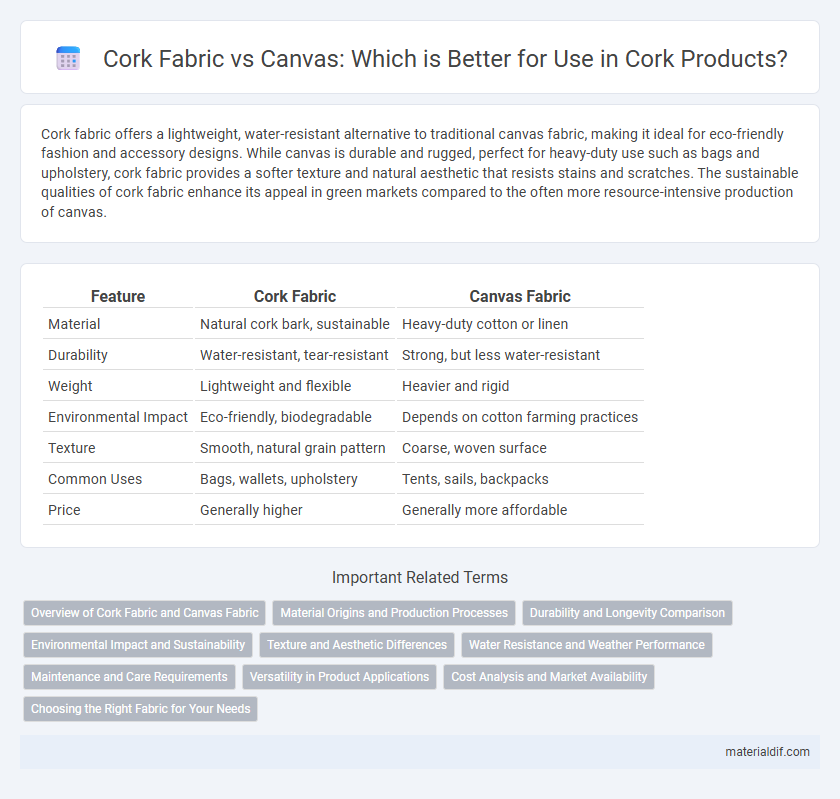Cork fabric offers a lightweight, water-resistant alternative to traditional canvas fabric, making it ideal for eco-friendly fashion and accessory designs. While canvas is durable and rugged, perfect for heavy-duty use such as bags and upholstery, cork fabric provides a softer texture and natural aesthetic that resists stains and scratches. The sustainable qualities of cork fabric enhance its appeal in green markets compared to the often more resource-intensive production of canvas.
Table of Comparison
| Feature | Cork Fabric | Canvas Fabric |
|---|---|---|
| Material | Natural cork bark, sustainable | Heavy-duty cotton or linen |
| Durability | Water-resistant, tear-resistant | Strong, but less water-resistant |
| Weight | Lightweight and flexible | Heavier and rigid |
| Environmental Impact | Eco-friendly, biodegradable | Depends on cotton farming practices |
| Texture | Smooth, natural grain pattern | Coarse, woven surface |
| Common Uses | Bags, wallets, upholstery | Tents, sails, backpacks |
| Price | Generally higher | Generally more affordable |
Overview of Cork Fabric and Canvas Fabric
Cork fabric, derived from the bark of cork oak trees, is a sustainable and lightweight material known for its water resistance and unique textured appearance. Canvas fabric, typically made from cotton or linen, offers a durable and breathable surface ideal for a wide range of applications including bags, tents, and art surfaces. Both materials provide versatility, with cork fabric excelling in eco-friendly and moisture-resistant uses, while canvas fabric stands out for strength and ease of customization.
Material Origins and Production Processes
Cork fabric is derived from the bark of the cork oak tree, primarily harvested in Mediterranean regions like Portugal, where the bark regenerates without harming the tree, making it a sustainable and renewable resource. In contrast, canvas fabric is traditionally made from cotton or linen fibers, woven tightly to create a durable textile commonly produced through extensive agricultural and weaving processes. The cork fabric production involves minimal processing with natural adhesives, while canvas undergoes spinning, weaving, and sometimes chemical treatments to enhance strength and texture.
Durability and Longevity Comparison
Cork fabric offers exceptional durability due to its natural resistance to water, stains, and scratches, making it ideal for long-lasting, eco-friendly products. Canvas fabric boasts strong tensile strength and can endure heavy wear and tear, especially when treated with protective coatings. While canvas may require more maintenance to prevent damage, cork fabric's inherent resilience provides longer-lasting performance with minimal care.
Environmental Impact and Sustainability
Cork fabric is derived from the bark of cork oak trees, making it a renewable and biodegradable material with a low environmental footprint due to minimal processing and chemical use. Canvas fabric, typically made from cotton, requires significant water, pesticide use, and energy during cultivation and production, resulting in a higher environmental impact. Cork fabric's sustainable harvesting process preserves the forest ecosystem, positioning it as an eco-friendlier alternative to conventional canvas.
Texture and Aesthetic Differences
Cork fabric features a smooth, slightly textured surface with natural variations and a matte finish, offering an eco-friendly and modern aesthetic ideal for minimalist designs. Canvas fabric exhibits a coarser, woven texture with visible fibers, providing a rugged, durable look favored in traditional and rustic styles. The tactile contrast between cork's soft flexibility and canvas's stiff sturdiness significantly influences their visual appeal and practical applications.
Water Resistance and Weather Performance
Cork fabric offers superior water resistance and natural weatherproofing due to its dense, impermeable structure, making it highly durable against moisture and environmental changes. Canvas fabric, while breathable and sturdy, typically requires waterproof coatings to enhance its water resistance and prevent damage from prolonged exposure to wet conditions. In outdoor applications, cork fabric maintains performance without additional treatments, whereas canvas depends on maintenance for effective weather protection.
Maintenance and Care Requirements
Cork fabric requires minimal maintenance, needing only occasional wiping with a damp cloth to remove dirt and prevent damage, while it naturally resists water and stains. Canvas fabric demands more frequent cleaning, especially when exposed to dirt or moisture, and may require gentle washing or spot cleaning to avoid fabric degradation. Both materials benefit from avoiding prolonged exposure to direct sunlight to maintain their durability and appearance.
Versatility in Product Applications
Cork fabric offers exceptional versatility, commonly used in eco-friendly fashion accessories, upholstery, and sustainable home decor due to its lightweight, flexible, and water-resistant properties. Canvas fabric excels in heavy-duty applications such as backpacks, tents, and outdoor gear because of its durability, breathability, and robust texture. Both materials provide unique benefits tailored to specific product needs, with cork emphasizing sustainability and softness while canvas highlights strength and resilience.
Cost Analysis and Market Availability
Cork fabric typically costs more than canvas fabric due to its eco-friendly sourcing and unique production process, positioning it as a premium material in the market. Canvas fabric benefits from widespread availability and lower production costs, making it a budget-friendly option for large-scale applications. Market analysis shows canvas dominates due to affordability and versatility, while cork fabric appeals to niche markets seeking sustainable and luxury products.
Choosing the Right Fabric for Your Needs
Cork fabric offers a lightweight, water-resistant, and eco-friendly alternative to traditional canvas, making it ideal for sustainable fashion and accessories. Canvas fabric provides durability, breathability, and ease of customization, suited for heavy-duty applications like bags, tents, and upholstery. Selecting between cork and canvas fabric depends on prioritizing sustainability and unique texture versus strength and versatility for your specific projects.
Cork Fabric vs Canvas Fabric Infographic

 materialdif.com
materialdif.com